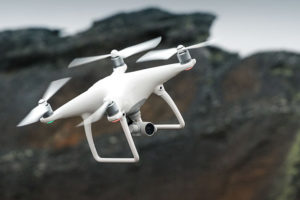 New drones keep swarming the market, but if you see a drone flying overhead, odds are that it is one of DJI’s Phantom-family models that are widely used by serious amateurs and professional alike. The newest member of the family, the Phantom 4, is finally here and ready for summer film projects. The Phantom 4 comes preassembled and ready to fly out of the box (after a summary firmware update and system check, of course).
New drones keep swarming the market, but if you see a drone flying overhead, odds are that it is one of DJI’s Phantom-family models that are widely used by serious amateurs and professional alike. The newest member of the family, the Phantom 4, is finally here and ready for summer film projects. The Phantom 4 comes preassembled and ready to fly out of the box (after a summary firmware update and system check, of course).
Like many of the new drones on the market, the pilot can control the Phantom 4 with an app on an Android or Apple tablet in conjunction with a controller. Abilities like “return home” are practical features common in the biz. But what does the Phantom 4 offer that its predecessors didn’t?
Firstly, the Phantom 4 has dramatically increased battery life with the largest Phantom battery to date. Maximum flight time is an impressive 28 minutes with a maximum control range of 3.1 miles (according to DJI). Consumers report flight times that are three or four times longer than the Phantom 3, which means more quality footage before battery swaps.
Secondly, the Phantom 4 boasts a tracking feature that follows a target designated by the pilot. That’s right, you can select a target, like your friend’s jaw-dropping yacht motoring past, and the drone will do everything it can to keep the target in the shot. With a top speed of 44 mph, it usually does pretty well. The Phantom 4 reportedly flies steadier than previous models with an improved gimbal system to keep the camera steady for a clean shot in a breeze.
Thirdly, the Phantom 4 is the first drone in DJI’s family to feature a rudimentary collision-avoidance system that’s guided by two small front-facing cameras. When the collision-avoidance system is activated, the drone will avoid objects in the way, even if you give it a direct order to fly into a bridge. You can turn off the collision avoidance if you are maneuvering in tight indoor conditions, but don’t blame the drone if it doesn’t go well.
The list of less dramatic improvements include a “TapFly” feature, where you simply tap a location on your map display and the drone flies there. The rotors have a novel adapter that makes installing and removing the blades a piece of cake. The Phantom 4 essentially builds off the success of its legacy with smart tweaks while introducing a few cutting-edge features for a superior drone worthy of the Phantom family name.
What’s more, the durable foam box the drone comes in is reusable as a travel case. The basic package is $1,399 and includes a radio controller, a single lithium-ion battery, a charger, two sets of propellers, a 16GB micro-SD memory card, and other accessories. The premium kit sells for $2,066 with two extra batteries and a backpack.